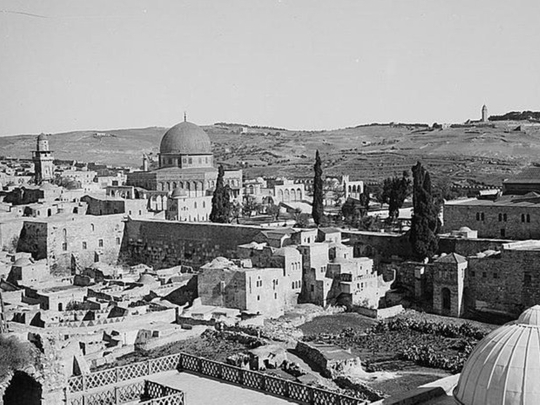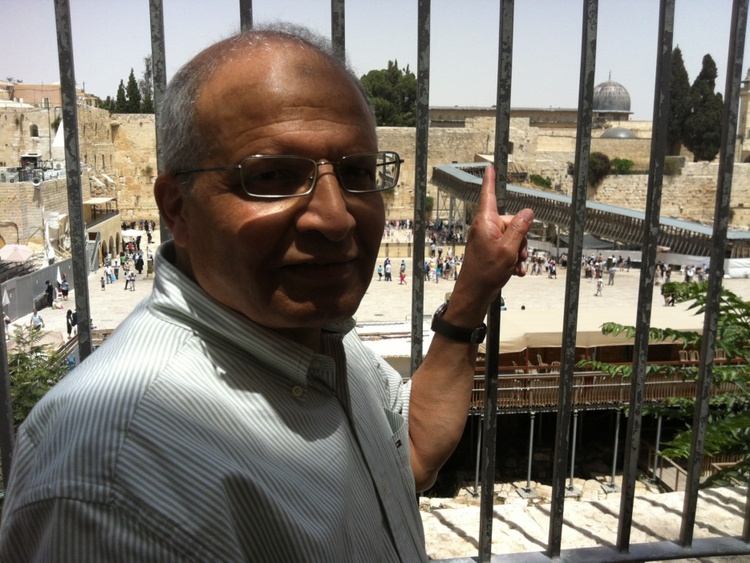
Little is known about the erstwhile Moroccan Quarter in the Old City of Occupied Jerusalem, and the Moroccans who came here in the 12th century, drawn to the Holy Land by Al Aqsa Mosque.
Noura Al Tijani explains its history. “In 1475, the Moroccan Quarter was given as waqf [endowment] for the Moroccans by Sultan Salah Al Deen as a reward for their bravery during the Crusades and their crucial role in liberating Jerusalem. Several religious and scientific institutions were set up in the quarter, and they contributed much to the social, scientific and cultural development of the community in Jerusalem.”
However, after the end of the 1967 war, the Moroccan Quarter was razed to the ground to make way for the Al Buraq Wall.
“The Moroccan Quarter housed structures such as the Al Buraq Mosque with its corner located outside Al Haram Al Sharif, the Al Afdal Mosque with Shaikh Hassan shrine in one corner, and the Al Magharbeh Mosque and Al Maghribial’s house, which were unfortunately demolished,” Al Tijani says.
The process of removing the inhabitants of the Moroccan Quarter was initiated swiftly and with uncompromising severity. Hundreds of residents were given just two hours’ notice to vacate their homes. Those who refused were forcibly evicted, as bulldozers were brought in to raze the structures here.
At the time of demolition, roughly half of the neighbourhood‘s residents traced their lineage to the Maghreb. Many of them returned to Morocco via Amman with the assistance of King Hassan II. Other families from the neighbourhood found refuge in the Shu’fat Refugee Camp and elsewhere in Occupied Jerusalem.
Dr Amin Tijani is the son of a man who journeyed to Palestine from Morocco in the 1920s. “My father was a religious man, and after making his pilgrimage to Makkah, he had to visit Bait Al Maqdis [Al Aqsa] to complete it. He fell in love with the place and decided to stay here. He had a special room in Al Aqsa. He used to deliver lectures after the Asr prayers, something he did for 25 years.”
But his stay was not easy. “It was during the Ottoman rule and they wanted to recruit my father, who had a simple grocery store in the Old City, into the army. He refused and moved out of the area. The Turks searched for him but could not find him.”
Tijani’s father moved to east of the River Jordan to begin a new life. “He started buying and selling wheat. But the Turkish army soon discovered this and imprisoned him,” he says. “After spending time in prison, my father moved to Shoaib Valley in Jericho, which was a dangerous place. There he got into farming and began buying and selling land. He was a tough man and knew what he wanted.”
Tijani describes the trauma his and other displaced families have experienced ever since their eviction in 1967. “The Jews demolished the whole area. We moved to [Occupied] East Jerusalem, and onwards to Ramallah, where we arrived in 1976. My father moved to Amman. Some of us stayed here, worked with the Israeli Administration so we could obtain their IDs. I worked in the public health sector as a doctor. We had to accept this because we thought it important to settle and live here, due to both religious and national obligations. My father passed away in 1981 in Jericho. He is buried in the cemetery adjoining Al Aqsa, near Bab Al Rahma [Gate of Mercy].”
Tijani recalls how Jews and Muslims from Morocco lived together in the Moroccan Quarter. “My father bought a house in West Jerusalem in Katamon in 1947, but it was taken by Jews in 1948. We have documents proving that it belongs to us. Today four Moroccan Jews live there. In the Moroccan Quarter, Muslims and Jews both from Morocco lived together. My father told me about the time when I was an infant and had fallen ill. A Jewish doctor from the Quarter had treated my illness.”
Noura Al Tijani adds, “Initially, the Moroccans added a new tinge in the diverse Palestinian society. We then integrated into the community. Today, we can talk about a Moroccan community in Palestine only in the pre-Occupation period. The contemporary Moroccan presence in Palestine consists of Palestinian families whose roots go back to North Africa. These families are not very different from local Palestinians.
“Despite Moroccans’ smooth integration into the Palestinian society, they still retain many of their traditions, especially those related to food, clothing and Ramadan rituals. If you’re invited to a Moroccan house during Ramadan, you will be greeted by the aroma of Al Harira soup. The soup is known for its exquisite taste and high nutritional value. You will also find on the Moroccan table a special dish called maftool or cuscusoon, made of semolina and wheat, and cooked in steam. A sauce of onion, meat and vegetables is also served with maftool to make a delicious dish.”
One thing that’s been lost is traditional attire. “The Moroccans in Jerusalem wore the traditional al qiftan — a hooded, long and loose flowing garment. Al qiftan is no longer popular among the Moroccans,” Al Tijani says.
“The Moroccans in Palestine have become an integral and inseparable part of the cultural fabric. With this intermarriage, you’d hardly find any difference between them and local Palestinians. They have blended into the Palestinian melting pot, like the harmonious notes in the songs of freedom and independence for Palestine.”
Rafique Gangat, author of “Ye Shall Bowl on Grass”, is based in Occupied Jerusalem.













